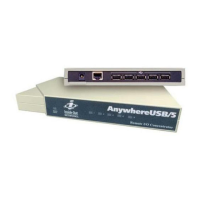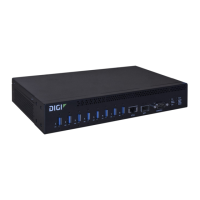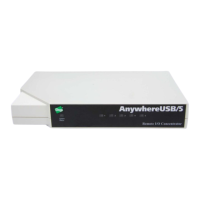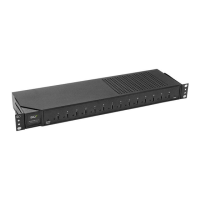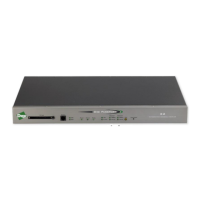Interfaces Local Area Networks (LANs)
AnywhereUSB® Plus User Guide
189
n
Custom: Allows you to identify the IP address of a Custom gateway to be
broadcast.
The default is Automatic.
c. For MTU,
n
None: An MTU of length 0 is broadcast. This is not recommended.
n
Automatic: No MTU is broadcast and clients will determine their own MTU.
n
Custom: Allows you to identify a Custom MTU to be broadcast.
The default is Automatic.
d. For Domain name suffix, type the domain name that should be appended to host names.
e. For Primary and Secondary DNS, Primary and Secondary NTP server, and Primary and
Secondary WINS server, select either:
n
None: No server is broadcast.
n
Automatic: Broadcasts the AnywhereUSB Plus device's server.
n
Custom: Allows you to identify the IP address of the server.
f. For Bootfile name, type the relative path and file name of the bootfile on the TFTP server.
g. For TFTP server name, type the IP address or host name of the TFTP server.
10. See Configure DHCP options for information about Custom DHCP options.
11. See Map static IP addresses to hosts for information about Static leases.
12. Click Apply to save the configuration and apply the change.
Command line
1. Log into the AnywhereUSB Plus command line as a user with full Admin access rights.
Depending on your device configuration, you may be presented with an Access selection
menu. Type admin to access the Admin CLI.
2. At the command line, type config to enter configuration mode:
> config
(config)>
3. Enable the DHCP server for an existing LAN. For example, to enable the DHCP server for a LAN
named my_lan:
(config)> network interface my_lan ipv4 dhcp_server enable true
(config)>
See Configure a LAN for information about creating a LAN.
4. (Optional) Set the amount of time that a DHCP lease is valid:
(config)> network interface my_lan ipv4 dhcp_server lease_time value
(config)>
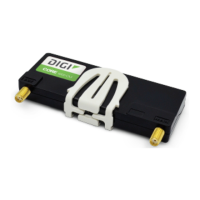
